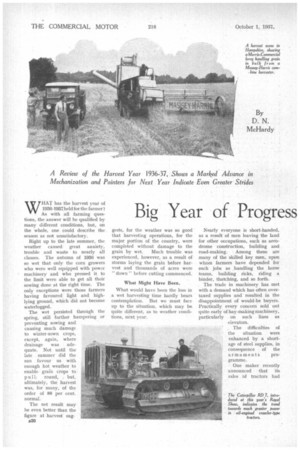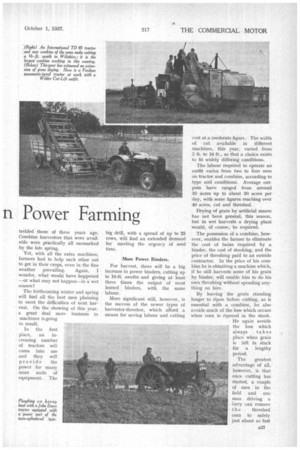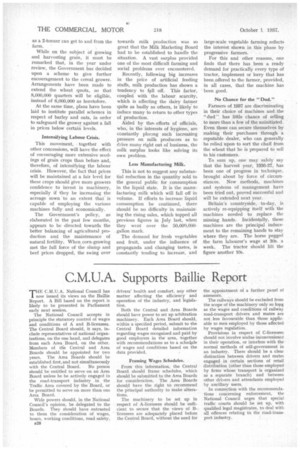Big Year of Progress n Power Farming
Page 36

Page 37

Page 38

If you've noticed an error in this article please click here to report it so we can fix it.
WHAT has the harvest year of 1936-1937 held for the farmer? As with all farming questions, the answer will be qualified by many different conditions, but, on the whole, one could describe the season as not unsatisfactory.
Right up to the late summer, the weather caused great anxiety, trouble and waste to nearly all classes. The autumn of 1936 was so wet that only the corn growers who were well equipped with power machinery and who pressed it to the limit were able to get all their sowing done at the right time. The only exceptions were those farmers having favoured light and highlying ground, which did not become waterlogged.
The wet persisted through the spring, still further hampering or preventing sowing and causing much damage to winter-sown crops, except, again, where drainage was adequate. Not until the late summer did the sun favour us with enough hot weather to enable grain crops to pull round, , but, ultimately, the harvest was, for many, of the order of 80 per cent. normal.
The net result may be even better than the figure at harvest sug s26 gests, for the weather was so good that harvesting operations, for the major portion of the country, were completed without damage to the grain by wet. Much trouble was experienced, however, as a result of storms laying the grain before harvest and thousands of acres were " down" before cutting commenced.
What Might Have Been.
What would have been the loss in a wet harvesting time hardly bears contemplation. But we must face up to the situation, which may be quite different, as to weather conditions, next year.
Nearly everyone is short-banded, as a result of men leaving the land for other occupations, such as aerodronae construction, building and road-making. Among these are many of the skilled key men, upon whom farmers have depended for such jobs as handling the horse teams, building ricks, riding a binder, thatching, and so forth.
The trade in machinery has met with a demand which has often overtaxed supplies and resulted in the disappointment of would-be buyers. Practically every concern sold out quite early of hay-making machinery, particularly on such lines as elevators.
The difficulties of the situation were enhanced by a shortage of steel supplies, in consequence of the armaments programme.
One maker recently announced that its sales of tractors had trebled those of three years ago. Combine harvesters that were available were practically all earmarked by the late spring.
Yet, with all the extra machines, farmers had to help each other out to get in their crops, even in the fine weather prevailing. Again, I wonder, what would have happened —or what may not happen—in a wet season?
The forthcoming winter and spring will find all the best men planning to meet the difficulties of next harvest. On the showing of this year, a great deal more business in machines is going to result.
In the first place, an increasing number of tractors will come into use and they will provide the power for many more units of equipment. The
For harvest, there will be a big increase in power binders, cutting up to 10-ft. swaths and giving at least three times the output of most horsed binders, with the same labour.
More significant still, however, is the success of the newer types of harvester-thresher, which afford a means for saving labour and cutting cost at a moderate figure. The width of cut available in different machines, this year, varied from 5 ft. to 16 ft., so that a choice exists to fit widely differing conditions.
The labour required to operate an outfit varies from two to four men on tractor and combine, according to type and conditions. Average outputs have ranged from around 10 acres up to about 30 acres per day, with some figures reaching over 40 acres, cut and threshed.
Drying of grain by artificial means has not been general, this season, but in wet harvests a drying plant would, of course, be required.
The possession of a combine, however, enables the farmer to eliminate the cost of twine required by a binder, the cost of stooking, and the price of threshing paid to an outside contractor. In the price of his combine he is obtaining a machine which, if he still harvests some of his grain by binder, will enable him to do his own threshing without spending anything on hire.
By leaving the grain standing longer to ripen before cuffing, as is essential with a combine, he also avoids much of the loss which occurs when corn is ripened in the stook.
He again avoids the loss which always takes place when grain is left in stack for a lengthy period.
The greatest advantage of all, however, is that once cutting has started, a couple of men in the field and one man driving a lorry can remove the threshed corn to safety just about as fast as a 2-tonner can get to and from the farm.
While on the subject of growing and harvesting grain, it must be remarked that, in the year under review, the Government has decided upon a scheme to give further encouragement to the cereal grower. Arrangements have been made to extend the wheat quota, so that 8,000,000 quarters will be eligible, instead of 6,000,000 as heretofore.
At the same time, plans have been laid to institute parallel schemes in respect of barley and oats, in order to safeguard the grower against a fall in prices below certain levels.
Intensifying Labour Crisis.
This movement, together with other concessions, will have the effect of encouraging more extensive seeding,s of grain crops than before and, therefore, of intensifying the labour crisis. However, the fact that prices will be maintained at a fair level for these crops should give more growers confidence to invest in machinery, especially if they be increasing the acreage sown to an extent that is capable of employing the various machines fully and economically.
The Government's policy, as elaborated in the past few months, appears to be directed towards the better balancing of agricultural production and the maintenance of natural fertility. When corn-growing met the full force of the slump and beef prices dropped, the swing over towards milk production was so great that the Milk Marketing Board had to be established to handle the situation. A vast surplus provided one of the most difficult farming and social problems ever encountered.
Recently, following big increases in the price of artificial feeding stuffs, milk production has shown a tendency to fall off. This factor, coupled with the labour scarcity, which is affecting the dairy farmer quite as badly as others, is likely to induce many to return to other types of production.
Aided by theefforts of officials, who, in the interests of hygiene, are constantly placing such increasing pressure on milk producers as to drive many right out of business, the milk surplus looks like solving its own problem.
Less Manufacturing Milk.
This is not to suggest any substantial reduction in the quantity sold to the general public for consumption in the liquid state. It is the manufacturing milk which will fall off in volume. If efforts to increase liquid consumption be continued, there should be no difficulty in maintaiuing the rising sales, which topped all previous figures in July last, when they went over the 50,000,000gallon mark.
The demand for fresh vegetables and fruit, under the influence of propaganda and changing tastes, is constantly tending to increase, and large-scale vegetable farming reflects the interest shown in this phase by progressive farmers.
For this and other reasons, one finds that there has been a ready demand for practically every type of tractor, implement or lorry that has been offered to the farmer, provided, in all cases, that the machine has been good.
No Chance for the "Dud."
Farmers of 1937 are discriminating in their choice of machines and the. " dud " has little chance of selling to more than a few of the uninitiated. Even those can secure themselves by making their purchases through a reputable dealer, who can generally be relied upon, to sort the chaff from the wheat that he is prepared to sell to his customers.
To sum up, one may safely say that the harvest year, 1936-37, has been one of progress in technique, brought about by force of circumstances. New methods, machines and systems of management have been tried out, proved successful and will be extended next year.
Britain's countryside, to-day, is actively re-equipping itself with the machines needed to replace the missing hands. Incidentally, those machines are the principal inducement to the remaining hands to stay where they are. The horse pegged the farm labourer's wage at 30s. a week. The tractor should lift the figure another 10s.




















































































